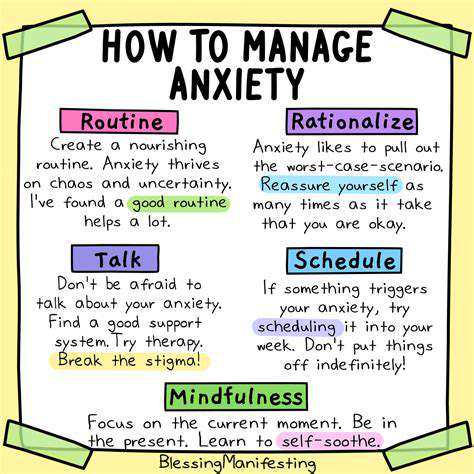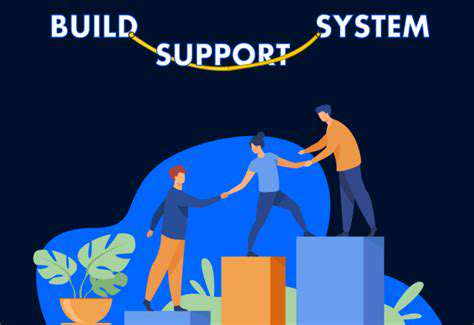Combatting Restlessness and Anxiety in a Fast Paced World
Identifying the Causes of Restlessness and Anxiety
Understanding Personal Triggers
Restlessness and anxiety often stem from personal triggers that vary from individual to individual. These triggers can include specific situations, thoughts, or even physical environments that provoke feelings of unease or tension. By closely examining your daily life and identifying scenarios where anxiety peaks, you can begin to understand what specifically fuels your feelings of restlessness.
Keeping a journal can be an effective method for tracking these triggers. By documenting your thoughts, feelings, and circumstances surrounding anxiety-inducing events, you can discern patterns that provide insight into your emotional responses. Once identified, you can develop strategies to mitigate these triggers, leading to a more peaceful state of mind.
The Impact of Social Media and Technology
In our hyper-connected world, social media and technology play a significant role in influencing our mental well-being. Constant exposure to curated lifestyles on social platforms can create feelings of inadequacy, leading to increased anxiety and restlessness. The pressure to stay active and engaged online can also overwhelm individuals, contributing to mental fatigue.
To combat this, it may be beneficial to set boundaries around your technology use. Designating specific times for social media or tech-free periods during the day can help alleviate stress and allow for moments of calm. Engaging in offline activities can also foster a sense of presence and improve overall mental health.
Lifestyle Factors Contributing to Anxiety
Your lifestyle choices can significantly impact your levels of restlessness and anxiety. Factors such as sleep quality, exercise, and nutrition play critical roles in emotional well-being. Poor sleep, for example, has been linked to heightened anxiety and decreased focus. Similarly, a lack of physical activity can lead to pent-up energy, which often manifests as restlessness.
Improving these lifestyle factors can have a profound effect on your mental state. Prioritizing regular physical activity, maintaining a balanced diet, and establishing a consistent sleep schedule can all contribute to a more stable mood and reduced feelings of anxiety. Small, achievable changes can lead to significant improvements over time.
The Role of Mindfulness and Stress Management Techniques
Mindfulness practices and stress management techniques can be powerful tools in combatting feelings of restlessness and anxiety. Techniques such as meditation, deep breathing exercises, and yoga promote relaxation and help individuals reconnect with their inner selves. These practices encourage a focus on the present moment, allowing you to detach from overwhelming thoughts and concerns about the future.
Incorporating mindfulness into your daily routine doesn't require extensive time commitments. Even a few minutes of focused breathing or a short meditation session can significantly reduce anxiety levels. Over time, these techniques can help create a more balanced and resilient mindset, equipping you to handle life's challenges with greater ease.
The Physical Impact of Anxiety
The Connection Between Anxiety and Physical Health
Anxiety does not only affect mental well-being; it can manifest physically, leading to various health issues. Individuals experiencing ongoing anxiety might notice increased muscle tension, headaches, or gastrointestinal discomfort. The body's stress response can trigger a range of symptoms, and the longer the anxiety persists, the more pronounced these physical effects can become.
Understanding the Fight or Flight Response
The fight or flight response is a natural reaction to stress that prepares our body to either confront a threat or flee from it. When a person experiences anxiety, their body may remain in this heightened state even in the absence of an immediate danger. This prolonged activation can exhaust the body and impair its normal functioning, leading to fatigue and a sense of overwhelm.
Symptoms of Anxiety on the Body
Anxiety can present numerous physical symptoms that range from mild discomfort to debilitating pain. Common manifestations include a racing heart, shortness of breath, sweating, and trembling. Some individuals may also experience feelings of dizziness or lightheadedness, often mistaken for other health issues.
Managing Physical Symptoms through Lifestyle Changes
When to Seek Professional Help
Strategies for Managing Restlessness and Anxiety

Understanding the Root Causes of Restlessness
To effectively combat restlessness, it is essential to first understand its underlying causes. Various factors such as stress from work, personal relationships, or financial pressures can contribute significantly. Recognizing these triggers helps individuals create a tailored approach to managing their feelings. Additionally, lifestyle choices such as diet and lack of physical activity can exacerbate symptoms. Mindfulness and introspection can reveal patterns in thoughts and behaviors that lead to restlessness. Addressing these root issues is vital for long-term relief.
Another major aspect to consider is the impact of technology on our mental well-being. Constant access to social media and news can often lead to an overstimulated state, increasing feelings of anxiety. In today's hyper-connected world, finding time to disconnect is crucial. Individuals might benefit from setting boundaries regarding their technology use, allowing them to focus on more fulfilling activities.
It's also worth noting how environmental factors, such as living conditions or geographical location, can influence restlessness. Urban areas often contribute to a fast-paced lifestyle that can heighten feelings of anxiety. Finding a balance between environments that stimulate and those that provide calm can dramatically affect mental health. Therefore, considering changes in physical surroundings can be a powerful tool in managing restlessness.
Lastly, social connections play a significant role in how we perceive and cope with anxiety. Sharing experiences with trusted friends or family can lessen feelings of isolation. Many individuals find relief in support groups or community activities which provide both connection and understanding.
Practical Techniques for Reducing Anxiety
Implementing practical techniques into daily life is key for managing anxiety. One of the simplest yet effective methods is developing a consistent routine. A structured day can provide a sense of predictability and security, which can be immensely calming. Incorporating time for relaxation can also help to counterbalance periods of high stress.
Mindfulness practices such as meditation and deep-breathing exercises are effective for immediate relief from anxious thoughts. Taking just a few moments to breathe deeply can ground individuals in the present moment, reducing feelings of overwhelm. Regular practice of mindfulness can help in building resilience against anxiety over time. Techniques such as journaling can also help process feelings and thoughts that contribute to restlessness.
Physical activity is another excellent way to manage anxiety. Exercise releases endorphins, which naturally improve mood and promote a sense of well-being. Activities such as walking, yoga, or team sports can serve as both a distraction and a therapeutic outlet. Allocating time for regular physical activity can be a game changer for managing anxiety.
Lastly, professional help should not be overlooked. Therapy or counseling can provide valuable strategies tailored to individual needs. Mental health professionals can guide individuals through their feelings, offering new perspectives and coping mechanisms.
Building a Support System

Understanding the Importance of Support Networks
Having a support network plays a crucial role in managing restlessness and anxiety. Support systems provide a space where individuals can express their feelings without judgment. Friends, family, and community members can offer invaluable assistance during challenging times. They help us to cope with stress by providing different perspectives and solutions.
Moreover, these networks facilitate social interaction, which is fundamental for emotional health. Engaging with others can reduce feelings of isolation, making it easier to tackle anxiety. Supportive relationships often lead to improved mental well-being and resilience.
Additionally, formal support groups, whether online or in-person, can connect you with others who are experiencing similar issues. This shared understanding fosters a sense of belonging and normalization of anxiety. When we see others navigating the same challenges, it can inspire hope and motivate us to seek help.
Overall, investing time in building and maintaining a support system is essential for fostering a balanced mental state. It’s important to remember that reaching out for help is a sign of strength, not weakness.
Strategies for Building Your Support System
Start by identifying individuals in your life who can serve as pillars of support. This may include close friends or family members who listen and understand your concerns. Establishing open communication is the first step in deepening these relationships.
Consider seeking out local community groups or online platforms that align with your interests. Engaging in activities such as hobby clubs or wellness workshops not only broadens your social circle but also introduces you to like-minded individuals. These connections can turn into strong support systems over time.
Participating in therapy or counseling can also be beneficial in constructing a reliable network. Therapists can provide guidance and may even connect you with broader support resources. This can become an additional layer of help in your journey toward managing anxiety.
Finally, don’t hesitate to express your needs clearly to those around you. Most people are willing to help, but they may not know how unless you communicate your feelings and desires. Building a support network requires effort and openness, but the benefits are well worth it.
The Role of Technology in Support Systems
In today’s digital age, technology can significantly enhance our support systems. Numerous apps and online communities provide resources and forums for individuals facing anxiety and restlessness. These platforms allow for anonymity and can make it easier for individuals to share their experiences.
Social media can also play a role in connecting with friends and family. Regular interactions—even just through short messages—can help maintain emotional ties and provide a sense of normalcy. Being able to reach out instantly can be reassuring in times of unrest.
Moreover, virtual therapy sessions have become increasingly popular, allowing people to seek professional support from the comfort of their homes. This convenience can reduce the pressure to seek help in person, making mental health services more accessible.
However, it's essential to balance online interactions with real-life connections to avoid feelings of isolation. Relying solely on technology for support can diminish the quality of relationships. Emphasizing both digital and physical forms of connection will enhance your overall support system.
Finding Balance in Modern Life
Understanding the Causes of Restlessness
Restlessness can often feel overwhelming, particularly in a world that is constantly buzzing with activity and information. One of the primary causes is the pressure to keep up with an unending flow of tasks, notifications, and social media interactions. The immediacy of digital communication can lead to a sense of urgency that leaves little room for relaxation or personal time.
Moreover, societal expectations and the pursuit of success can exacerbate feelings of anxiety. The need to achieve and perform often makes individuals feel inadequately prepared, which in turn increases restlessness. Recognizing these triggers is the first step towards addressing the issue and finding effective coping strategies.
Strategies for Finding Inner Calm
Developing a consistent mindfulness practice can be a powerful tool for combatting restlessness and anxiety. Techniques such as meditation, deep breathing exercises, and yoga can help center the mind and body, creating a respite from external chaos. Spending just a few minutes each day in focused silence can allow thoughts to settle and promote a greater sense of peace.
Additionally, incorporating physical activity into your routine, whether through walking, running, or other forms of exercise, can release endorphins that naturally elevate mood and reduce stress. A balanced approach that includes both mental and physical well-being can greatly enhance overall health and serenity.
Embracing Simplicity in Daily Life
Simplifying daily routines can significantly alleviate feelings of restlessness. Consider evaluating the commitments and responsibilities you take on; it may be beneficial to say 'no' to activities that don't align with your priorities or values. By reducing clutter in your schedule, you create additional space for relaxation and introspection.
Moreover, fostering a connection to nature can also play a vital role in enhancing mental clarity and calmness. Spending time outdoors, even in small doses, can provide a refreshing perspective and a break from the incessant demands of modern life. Cultivating these simple habits can lead to a more balanced and tranquil existence.